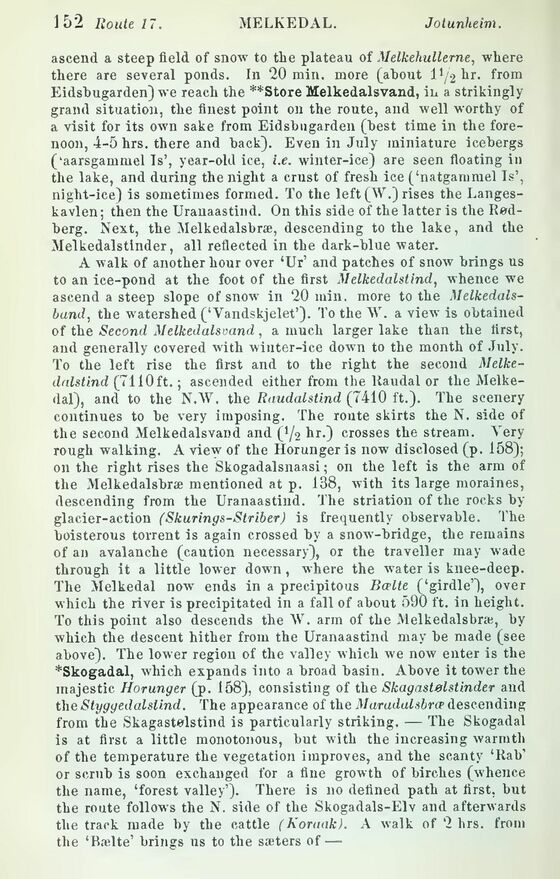
Full resolution (JPEG) - On this page / på denna sida - Norway - Pages ...

<< prev. page << föreg. sida << >> nästa sida >> next page >>
Below is the raw OCR text
from the above scanned image.
Do you see an error? Proofread the page now!
Här nedan syns maskintolkade texten från faksimilbilden ovan.
Ser du något fel? Korrekturläs sidan nu!
This page has never been proofread. / Denna sida har aldrig korrekturlästs.
ascend a steep field of snow to tlie plateau of Melkehullerne, where
there are several ponds. In 20 min. more (about l1/^ hr. from
Eidsbugarden) we reach the **Store Melkedalsvand, in a strikingly
grand situation, the finest point on the route, and well worthy of
a visit for its own sake from Eidsbugarden (best time in the
forenoon, 4-5 hrs. there and back). Even in July miniature icebergs
(‘aarsgammel Is’, year-old ice, i.e. winter-ice) are seen floating in
the lake, and during the night a crust of fresh ice (‘natgammel Is’,
night-ice) is sometimes formed. To the left (W.) rises the
Langes-kavlen; then the Uranaastind. On this side of the latter is the
Redberg. Next, the Melkedalsbræ, descending to the lake, and the
Melkedalstlnder, all reflected in the dark-blue water.
A walk of another hour over ‘Ur’ and patches of snow brings us
to an ice-pond at the foot of the first Melkedalstind, whence we
ascend a steep slope of snow in 20 min. more to the
Melkedals-bund, the watershed (‘Vandskjelet’). To the W. a view is obtained
of the Second Melkedalsvand , a much larger lake than the first,
and generally covered with winter-ice down to the month of July.
To the left rise the first and to the right the second
Melkedalstind (7110 ft.; ascended either from the liaudal or the
Melke-dal), and to the N.W. the Raudalstind (7410 ft.). The scenery
continues to be very imposing. The route skirts the N. side of
the second Melkedalsvand and (!/o hr.) crosses the stream. Very
rough walking. A view of the Horungeris now disclosed (p. 158);
on the right rises the Skogadalsnaasi; on the left is the arm of
the Melkedalsbræ mentioned at p. 138, with its large moraines,
descending from the Uranaastind. The striation of the rocks by
glacier-action (Skurings-Striber) is frequently observable. The
boisterous torrent is again crossed by a snow-bridge, the remains
of an avalanche (caution necessary), or the traveller may wade
through it a little lower down, where the water is knee-deep.
The Melkedal now ends in a precipitous Balte (‘girdle’), over
which the river is precipitated in a fall of about 590 ft. in height.
To this point also descends the W. arm of the Melkedalsbræ, by
which the descent hither from the Uranaastind may be made (see
above). The lower region of the valley which we now enter is the
*Skogadal, which expands into a broad basin. Above it tower the
majestic Horunger (p. 158), consisting of the Skagastølstinder and
the Styggedalslind. The appearance of the Maradalsbra descending
from the Skagastedstind is particularly striking. — The Skogadal
is at first a little monotonous, but with the increasing warmth
of the temperature the vegetation improves, and the scanty ‘Rab’
or scrub is soon exchanged for a fine growth of birches (whence
the name, ‘forest valley’). There is no defined path at first, but
the route follows the N. side of the Skogadals-Elv and afterwards
the track made by the cattle (Koraak). A walk of 2 hrs. from
the ‘Rælte’ brings ns to the sæters of —
<< prev. page << föreg. sida << >> nästa sida >> next page >>